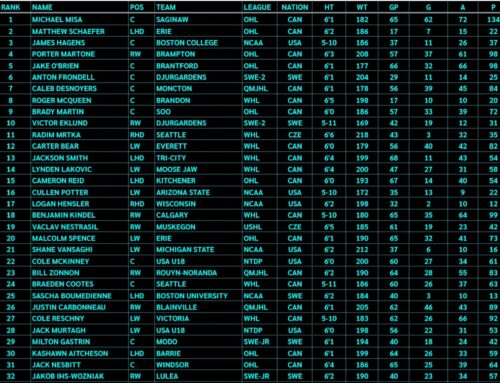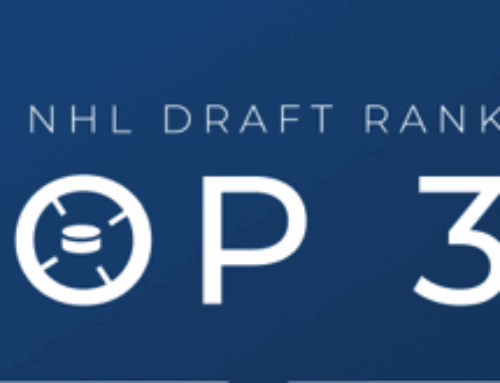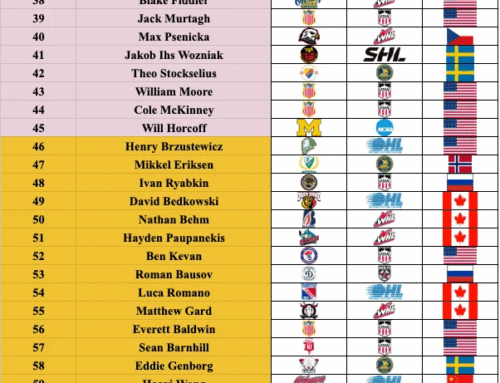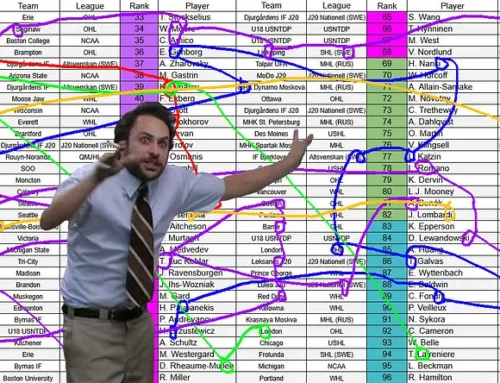Redesigning the CHL-NHL Agreement
Tony Ferrari
2021-03-03
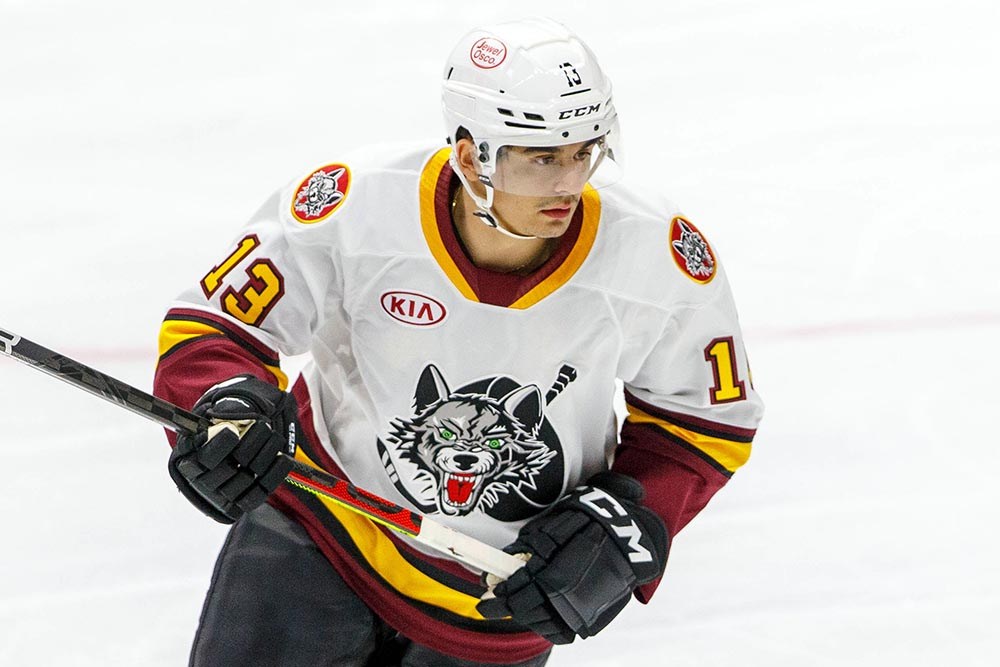
Photo courtesy of the Chicago Wolves/AHL
The NHL-CHL agreement has long been a complaint amongst fans, and even NHL teams to an extent. It is simple at its root. The base of it is that players have to be either 20 years old or have played four seasons in junior hockey before they can join an NHL team’s minor-league affiliate. This is a conundrum that is often talked about because there always seems to be a 19-year-old who is forced to go back to junior and then tears his league apart with ease because he was clearly too good for the CHL a year earlier.
The reality is that some years, there are players that would likely benefit from being able to play at the AHL level at 18 or 19 years old. Putting up over two points-per-game at the CHL level is impressive but it’s not necessarily the best thing for a prospect, especially if he came close to the mark as a draft-eligible prospect. Often times a prospect develops bad or lazy habits because the game just comes so easy to them.
This year, due to the global pandemic that has delayed the OHL and, until recently, the WHL, we have been given the chance to see many of the players drafted this past October in the AHL. To say they’ve been successful would be an understatement. Seth Jarvis, drafted 13th overall by Carolina, leads the AHL in scoring with 11 points in 9 games but was sent back to Portland on March 2nd because of the agreement. Jamie Drysdale, drafted 6th overall by Anaheim, was just named Rookie of the Month in the AHL thanks to his nine points in 11 games, good for a tie of the team lead. Zayde Wisdom, Nicholas Robertson, Quinton Byfield, Connor McMichael, and Phillip Tomasino, among others, are putting up big numbers for teenagers at the AHL level.
The future sure is bright.
Here’s a look at what the teenagers – who shouldn’t even be in the league, are doing in the AHL this year.
Nuts to pushing the draft back a year, let’s move it up one!
(I, mostly, kid) pic.twitter.com/zaLclpVRJK
— /Cam Robinson/ (@Hockey_Robinson) February 28, 2021
So what do we do with the NHL-CHL agreement? First, we have to look at why it’s in place. The primary reason it is in place, at the heart of it all, is the sustainability of the CHL and the three leagues (OHL, WHL, QMJHL) within it. If teams were allowed to take their drafted players out of their junior team’s hands at will when they are hitting their peak junior hockey years, you strip them of the reason many fans are in the buildings. The CHL is dependant on the gate revenue and people being in the building and in a typical year, they would feel the hit of losing a star like Drysdale or Byfield. The NHL needs the CHL to stay healthy and flourish because it is the largest feeder league (or trio of leagues) to the NHL. The more revenue those teams generate the better their ability to continue to improve in every aspect from off-ice training to skill development.
Having the best North American junior-aged players playing in the CHL allows them to showcase the leagues better and makes it easier to attract fans. The fans LOVE going to the rink and seeing the 16-year-old they watched two years prior take over as a drafted 18-year-old player. Whether it’s a player like Mitch Marner going back to the London Knights and leading the way to a Memorial Cup or Cody Glass returning to the WHL part way through the year to produce at almost two-points per game, there CHL relies on having those star 18 and 19-year-old players. These guys put fans in the stands and jerseys on their backs. Junior teams need that money, for both survival and improvement.
So what can be done? The agreement is up after this year, and while it’s been extended in the past, this presents a unique opportunity for the NHL and CHL the opportunity to get creative. This is even more evident after seeing the success that the kids have had early this season. The NHL seems to have a distaste for change in general, so this may all be a moot point at the end of the day. With that said, how can we ensure that the CHL stays healthy while also figuring out a way for players to have the best development path for their pro careers? Let’s take a look at a few ideas and why they may or may not work.
Abolish the Agreement, Let the Kids Play
Yeehaw! Let’s go! Right? This would be a really fun idea. Having players like Byfield and Drysdale in the AHL regularly would be a boon for the league. It would allow for some of the brightest young stars in the game to play with their NHL teams affiliate. Not every player would go because teams would be hesitant of forcing too much onto players but teams would almost routinely use the AHL for higher picks or players who are already physically developed but need to work on playing against stronger players because junior hockey isn’t challenging them in that regard.
This also gives the NHL team a more hands-on approach to development and allows them to flex their financial muscle to do it. They could give the player everything they need to succeed from the moment they are selected in their draft. Having the ability to focus on a prospect like Byfield is a great advantage for teams who can afford to dump heavy resources into development. Playing at the AHL level would give the prospects a taste of professional hockey and allows them to adjust to the level from a strength, speed, and skill perspective.
Zayde Wisdom gets his 6th of the season to tie the game, and he moves into a tie with his teammate Max Willman and Chicago's Seth Jarvis for the league's lead for goals by a rookie.
Great play by Ryan Fitzgerald to force the turnover and create the play, pic.twitter.com/h86FUirOA5
— Tony Androckitis (@TonyAndrock) February 28, 2021
Why it Will/Won’t Work
This would be detrimental for the CHL. Losing their best players every single year before they even get to their best years in junior could be awful for teams. It would likely also make the CHL a lower-scoring league. Why? Goalies and defenders are slower to develop and would likely be left in the CHL longer than forwards. If you take away all of the Seth Jarvis’ and Adam Beckman’s of the world but leave the Kaiden Guhle’s and Dustin Wolf’s, you get a league where all of the best – and oldest – players are trying to primarily thwart offense and the offensive players that would be able to compete with them are gone. 17-year-old forwards against 18 and 19-year-old defenders and goalies likely means that the CHL goes from being exciting, high-scoring, and built on fun to being slow, low-scoring, and enjoyed by only your Uncle from Burlington who wishes that “teams played defense like the old days” and that’s just not entertaining. (No offense to Burlington)
It would be a legitimately bad idea as well because despite saying teams wouldn’t send all of their prospects to the AHL, they would probably abuse this to a degree. Imagine for a second that a team getting frisky and sending a prized prospect to the AHL, a league that’s known for being a bit more physical and grinding. While the player would have a decent chance score, do we really want a physically immature player getting clobbered by a Jake Dotchin-type? The AHL is still a men’s league and allowing kids to play there at the will of their NHL team could lead to some disasters. A free-for-all might be a bit too much. NHL teams have a hard time getting out of their own way as it is, letting them take unneeded risks with prospects could be destructive to the player’s development.
Exceptional Status Rule for the Greats
The CHL, in association with the provincial hockey administration and Hockey Canada, already has one Exceptional Status rule. Exceptional player status is granted to a player whose qualities not only on the ice, but as a person, deem the player deserving of the rare privilege of participating in the Canadian Hockey League at an early age. Given to players such as Connor McDavid, Shane Wright, and most recently, Connor Bedard, the Exceptional Status rule is designed to allow for the rare case of a player who is “ready early” to play in the league.
Using the same logic, the NHL and CHL could put together a similar deal for allowing 18 and 19-year-olds into the AHL early. A perfect example of this situation can be found in Ontario. Not the province but the city in California where Quinton Byfield is currently playing with the Kings affiliate. If/when the OHL gets started, the Kings’ second overall pick this past October will have to head back to Sudbury. After putting up 82 points in just 45 games, good for 1.82 points-per-game, his OHL experience would be not only dominant but a waste of time if we are being completely honest. There is very little to prove for a 6’4″, 215lbs player who produced a ridiculous clip. Given that, the CHL and NHL could work together and come up with a once-in-a-blue-moon exemption that could be granted to a player in order to allow them to play at the AHL level. It would be rare. The CHL Exceptional Status has only been given out seven times since 2005 when John Tavares was the first player given the honor.
Seth Jarvis did this…..his 5th goal of the season and he has points in all six of his AHL games. He's doesn't need to go back to juniors. #IAvsCHI pic.twitter.com/crC4tpHEC7
— Greg Boysen (@GregBoysen) February 21, 2021
Why it Will/Won’t Work
Exceptional Status is an interesting concept at the AHL level. It could work in theory but there would be concerns about who is making the decisions and whether it would be fair that one team’s prospect could make the jump while other teams couldn’t have their star prospect in the minors. Part of the reason the rule works at the CHL level is that the status is granted before the league’s draft meaning that teams know that the player would be eligible to play early before picking them. The player goes right into the team’s lineup and isn’t being put into a minor league system. Exceptional Status has been very seldom given out in the grand scheme of things and it may be too limiting for NHL teams and the prospects that could make the AHL. If Byfield is given the status, it’s unlikely another player gets it that same year. How is it going to benefit Jarvis, the AHL scoring leader, to go back to the WHL – after notching 98 points in 58 games, good for a 1.68 points-per-game as a draft-eligible player last year? He might break 50 points in a 24 game season this year and that may be on the conservative side of things. In the grand scheme of things, an Exceptional Status in the framework of the CHL rule may be a bit too limiting if we are looking at the big picture.
CHL-NHL Agreement 2.0
The suggestion that seems to make the most sense is giving each team a Limited CHL-AHL Player Permit – the name is a work in progress. The idea behind this would be to allow each team the opportunity to choose one CHL prospect every so many years and grant them early entry to the AHL. The terms suggested have ranged from one per year to once every five years. The number that seems to make the most sense, in my mind at least, is four, the same number of years in a typical junior career. There has also been discussion about limiting the players to the first round which is certainly a wrinkle that could be added to this but opening it up to any drafted prospect gives a team a chance to test any prospect and if they choose to use it on a sixth-round prospect, all the power to them. This permit should be used sparingly and with a great deal of thought given to the situation. Teams shouldn’t be pushing prospects to the AHL prior to them being ready for many reasons, safety being among them.
Many great assists so far this season, but February's Assist of the Month goes to Quinton Byfield and Rasmus Kupari on Akil Thomas' goal! pic.twitter.com/hO7YACMpoa
— Ontario Reign (@ontarioreign) March 1, 2021
The four-year gap minimum gap between uses of the permit would give rebuilding teams the ability to take one of their prospects and get them in their system a bit sooner and allow contenders to test prospects that might just be the missing piece on a hopeful Stanley Cup run. The term is long enough that any team that uses it would have to wait until that prospect is 22 years old and playing his fourth pro season before bringing in the next teen AHLer. This means that it’s unlikely any AHL team will have multiple teenage players on the roster at once, and never more than one CHLer. In any given year, assuming 1/4 of the league uses the permit, you would have eight prospects from the CHL gone off to the AHL. Many times, it would be for their 19-year-old season as that is often the year that winds up being a bit redundant. This still leaves the majority of the best 18 and 19-year-old players in the CHL while giving teams a bit more flexibility.
Why is Will/Won’t Work
This seems like the closest thing to a compromise. The term length could be lengthened if the CHL really wants to be strict but anything more than five years would hamper the intended goal of the permit at its core: Giving the best of the best a chance to step up their competition and make real gains developmentally that they would likely not incur should they be forced into eviscerating the CHL to a tune of over two points-per-game while developing some lazy habits because the CHL just isn’t testing them any longer.
With just a small number of players heading off to the AHL, it leaves a hole in some lineups that can be filled by younger players who are ready for that next step as well. Finding roughly eight players to give a bit more prime ice-time to isn’t hard. could also benefit them in their development. With only having to replace eight spots, it also wouldn’t force too many younger players into bigger roles which could lead to the defensive shift in the CHL that was previously touched upon. This could be the balance we need.
At the End of the Day
Money talks. It is pretty obvious that a massive driving force in this agreement is that CHL teams already struggle to make money on a consistent basis in any major way. The business of junior hockey isn’t making millionaires. These teams need their stars to market and get fans excited to come to the rink. Some of these players could benefit from the step up to the AHL. There needs to be a balance between the two because, at the end of the day, the CHL is a developmental league that is feeding the NHL talent on a regular basis.
Would an NHL team paying a fee to their prospects CHL club be worth having the ability to pull that one prospect every four years? How big would that payment have to be? Would a base payment of one million dollars be sufficient? Teams waste money on dead contracts and buried deals all of the time. This money would be an investment into the future. Provide that team a bit of cash that helps make up for the prospect leaving and then some, allowing them to invest in their facilities or training staff or any number of things that may improve the next wave of players coming through the league.
He leads @TheAHL with 11 points and ranks second with seven goals, but 19-year-old @jarvy44 must head to Portland to rejoin his junior team.
Enjoy your season and your teammates!
Until we see you again…https://t.co/GpA3n0sMrd#WeAreTheWolves pic.twitter.com/yNiL9QTkF1
— Chicago Wolves (@Chicago_Wolves) March 2, 2021
Some may think that one million dollars a high price. Good. It provides another layer of deterrents for NHL teams to help provide the CHL team a level of security. That high price will give teams pause when considering using the permit on a player who could make the jump and save it for the player who needs to make the jump. Is there a worry that all of the high-end CHL teams such as London or Edmonton would wind up getting that payment and continuing to widen the gap between their developmental capabilities and the teams who struggle such as North Bay? They could work out a profit-sharing agreement amongst the league – OHL, WHL, or QMJHL not the CHL as a whole. The team losing the prospect could take a third or half of the fee and the remainder could be split amongst the league.
There likely is no perfect solution. This certainly isn’t that. Maybe this is all too complicated and the NHL opts to stick to the status quo and we are robbed from a Seth Jarvis ever trying to lead the AHL in scoring as a teenager. Quinton Byfield will go back to Sudbury and try to score 30 goals in the shortened 24-game season instead of challenging himself and learning from the Los Angeles development staff while playing with the Ontario Reign. There are players who can benefit from playing in the AHL early. The CHL needs to keep the majority of their best players to keep the league entertaining and engaging for fans. Compromise is key in life. This seems like a solution that could benefit both sides.
******
Thanks for joining me on my latest thought experiment, this time relating to the CHL-NHL Agreement. If you would like to reach out and discuss the idea more or poke holes in the plan, you can follow me on Twitter @theTonyFerrari and I’d be more than happy to discuss this or any variety of topics around the game. Check out my Top-64 for the 2021 NHL Draft with breakdowns and reasoning why the players are ranked where they are! One sentence prospect analysis is for chumps!



